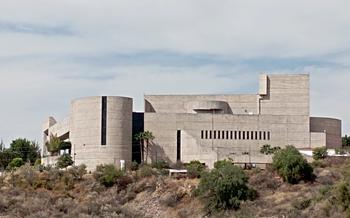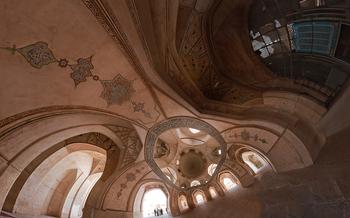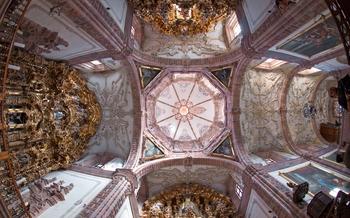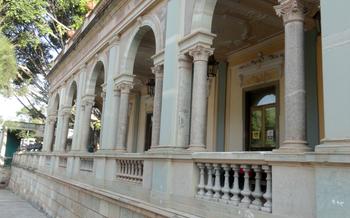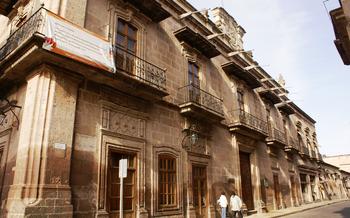
Museum of Sacred Art (Museo de Arte Sacro)
- History of the Building
- Location of the Museum
- Permanent Collection Highlights
- Temporary Exhibitions
- Educational Programs
- Accessibility
- Photography and Videography
- Children and Families
- Hours of Operation
- Admission Fees
- Visitor Information
- Insider Tip: Unveiling the Hidden Treasures of the Museum of Sacred Art
History of the Building
The Museum of Sacred Art is housed in a former Jesuit college that was built in the 17th century. The college was one of the most important educational institutions in New Spain, and it played a key role in the development of Mexican culture. The building was designed by the Jesuit architect Francisco de la Mora, and it is considered to be one of the finest examples of Baroque architecture in Mexico.
The college was closed in 1767 when the Jesuits were expelled from New Spain. The building was then used for a variety of purposes, including as a military barracks, a prison, and a school. In 1937, the building was declared a national monument, and it was restored and converted into a museum.
Location of the Museum
The Museum of Sacred Art is centrally located in the heart of Guanajuato City, a UNESCO World Heritage Site known for its colonial architecture and vibrant cultural scene. The museum is situated on Positos Street, just a short walk from the city's main square, the Jardín de la Unión. Visitors can easily reach the museum on foot from most of the city's hotels and attractions.
The museum is housed in the former Colegio de la Santísima Trinidad, a historic building that dates back to the 18th century. The area surrounding the museum is a charming neighborhood filled with narrow cobblestone streets, colorful buildings, and small shops. The neighborhood is home to several other cultural institutions, including the Museo Regional de Guanajuato and the Teatro Juárez, making it a popular destination for visitors interested in art and history.
The Museum of Sacred Art is easily accessible by public transportation. Several bus lines stop within a short walking distance of the museum, and the city's tourist trolley also has a stop nearby. The museum is also within walking distance of the city's main bus station, making it convenient for visitors arriving by bus from other parts of Mexico.
Permanent Collection Highlights
The permanent collection of the Museum of Sacred Art is a treasure trove of Mexican religious art, spanning from the colonial era to the present day. Among the most famous artworks is the painting "The Last Supper" by Miguel Cabrera, a masterpiece of the Mexican Baroque style. The painting depicts the biblical scene with a uniquely Mexican flavor, featuring local fruits and flowers on the table and the apostles dressed in traditional Mexican clothing.
Another highlight of the collection is the sculpture "The Descent from the Cross" by Francisco Tolsa, a renowned artist of the Neoclassical period. The sculpture captures the moment when Jesus is taken down from the cross, and his body is supported by his followers. The intricate details and emotional expressiveness of the figures make this sculpture a powerful and moving work of art.
Also on display is a collection of silver objects, including chalices, monstrances, and reliquaries. These objects showcase the skill and craftsmanship of Mexican silversmiths and are a testament to the importance of religious art in Mexican culture.
Finally, the museum houses a number of paintings by José María Velasco, one of the most celebrated Mexican landscape painters of the 19th century. Velasco's paintings capture the beauty and diversity of the Mexican landscape, and they offer a glimpse into the country's rich natural heritage.
Temporary Exhibitions
The Museum of Sacred Art periodically organizes temporary exhibitions to complement its permanent collection and provide visitors with a fresh and diverse perspective on sacred art. These exhibitions showcase the works of renowned Mexican and international artists, exploring various themes, styles, and techniques.
Past exhibitions have featured the works of renowned artists such as José Guadalupe Posada, Diego Rivera, and Frida Kahlo, as well as emerging contemporary artists. The themes explored in these exhibitions have ranged from the traditional iconography of Mexican Catholicism to the contemporary interpretations of faith and spirituality.
To stay informed about upcoming exhibitions, visitors can check the museum's website regularly or sign up for their email newsletter. The museum also organizes special events and activities in conjunction with its temporary exhibitions, such as artist talks, workshops, and guided tours. These events provide an opportunity for visitors to engage with the artworks and the artists themselves, gaining a deeper understanding and appreciation of the creative process.
Educational Programs
The Museum of Sacred Art offers a variety of educational programs designed to engage and inspire visitors of all ages. These programs include workshops, lectures, and classes that delve into the history, techniques, and significance of the museum's collection.
Workshops: The museum offers hands-on workshops that allow participants to create their own sacred art. These workshops are led by experienced artists and educators who guide participants through the creative process.
Lectures: The museum regularly hosts lectures by scholars, artists, and curators who share their insights on the history, techniques, and significance of the museum's collection. These lectures are open to the public and offer a unique opportunity to learn from experts in the field.
Classes: The museum offers classes that provide in-depth study of specific aspects of sacred art. These classes are taught by experienced instructors and cover a wide range of topics, including iconography, symbolism, and conservation.
Who can participate? Educational programs are open to people of all ages and backgrounds. Workshops are particularly suitable for families and individuals who enjoy hands-on learning. Lectures and classes are ideal for students, art enthusiasts, and anyone interested in deepening their understanding of sacred art.
How to register? To register for educational programs, please visit the museum's website or contact the museum directly. Advance registration is recommended to secure your spot.
Accessibility
The Museum of Sacred Art is committed to providing a welcoming and accessible environment for all visitors. The museum is wheelchair accessible, with ramps and elevators throughout the building. There are also accessible restrooms and a designated parking space for visitors with disabilities.
The museum's website and materials are also accessible, with screen-reading software and closed captioning for videos. The museum offers sign language interpretation and audio description tours for visitors with hearing or visual impairments.
For visitors with disabilities who require assistance, the museum offers a variety of services, including:
- Personal assistance with navigation and orientation
- Large print maps and brochures
- Touch tours for visitors with visual impairments
- ASL interpretation and audio description tours for visitors with hearing or visual impairments
To request assistance or accommodations, please contact the museum in advance.
Photography and Videography
Photography and videography are generally permitted within the Museum of Sacred Art, with a few restrictions to ensure the preservation of artworks and the privacy of visitors. Flash photography and tripods are not allowed, as they can damage the delicate paintings and sculptures. Visitors are also asked to be respectful of other visitors and to avoid taking photographs or videos that interfere with their enjoyment of the museum.
For professional photography or videography projects, a permit must be obtained from the museum in advance. The museum staff can provide information on the process and fees associated with obtaining a permit. Please note that commercial photography or videography for commercial purposes is not permitted without prior authorization.
Children and Families
The Museum of Sacred Art welcomes families with open arms, offering a variety of activities and programs designed to engage and educate young visitors. Interactive exhibitions, hands-on workshops, and storytelling sessions bring history and art to life, sparking curiosity and imagination in young minds.
Family-friendly events, such as themed tours, scavenger hunts, and craft workshops, are regularly organized to create memorable experiences for families. The museum also provides amenities like changing tables and strollers, making it easy for parents to navigate the museum with young children.
To ensure a smooth and enjoyable visit, it's recommended to plan ahead and check the museum's website or contact the education department for information on upcoming programs and events. With its captivating exhibits and engaging activities, the Museum of Sacred Art promises a fun and educational experience for the whole family.
Hours of Operation
The Museum of Sacred Art adheres to regular hours of operation throughout the week, with the exception of certain holidays or special events. From Tuesday through Saturday, the museum welcomes visitors from 10:00 AM to 5:00 PM. On Sundays, the hours are slightly shorter, with the museum opening at 10:00 AM and closing at 2:00 PM. However, it is essential to note that these hours may be subject to change, particularly during holidays or special occasions. Therefore, it is highly recommended to check the museum's official website or contact them directly to confirm the hours of operation before planning your visit to avoid any inconvenience.
Admission Fees
General admission to the Museum of Sacred Art is 25 pesos for adults, 15 pesos for children, and 10 pesos for seniors. The museum offers free admission to children under 6 years old, students with a valid ID, and visitors with disabilities.
Tickets can be purchased at the museum's ticket counter or online through the museum's website. Online ticket purchases are subject to a small processing fee.
Reservations are not required for general admission, but they are recommended for groups of 10 or more. Reservations can be made by calling the museum's reservations department or by emailing the museum directly.
The museum also offers a variety of discounts and promotions throughout the year, including free admission on certain days and discounts for AAA members, military personnel, and educators.
It is important to note that the museum may close occasionally for special events or maintenance. It is always a good idea to check the museum's website or call ahead to confirm hours of operation and admission fees before your visit.
Visitor Information
Upon entering the Museum of Sacred Art, you will find yourself in a welcoming and informative space. Maps, brochures, and audio guides in multiple languages are available to enhance your visit. The museum staff is friendly, knowledgeable, and eager to assist you. They can provide you with directions, answer your questions, and offer recommendations. Additionally, the museum's website is a valuable resource for planning your visit. It features detailed information about the collection, upcoming exhibitions, educational programs, and visitor services. If you require any special assistance or accommodations, such as wheelchair access or sign language interpretation, please do not hesitate to contact the museum in advance. They are committed to making your visit as enjoyable and accessible as possible.
Insider Tip: Unveiling the Hidden Treasures of the Museum of Sacred Art
To fully immerse yourself in the spiritual and artistic essence of the Museum of Sacred Art, consider visiting during the serene hours of the morning or late afternoon, when the crowds have dissipated. This tranquil ambiance allows you to connect deeply with the artworks and contemplate their profound messages.
As you wander through the galleries, keep an eye out for hidden gems tucked away in unexpected corners. One such treasure is the intricately carved wooden altarpiece located in the Sala de la Virgen de Guadalupe. This masterpiece, with its delicate details and vibrant colors, is a testament to the skill and devotion of the anonymous artisans who created it.
For a truly unique experience, inquire about the museum's occasional guided tours led by local experts. These knowledgeable guides share fascinating insights into the history, symbolism, and techniques behind the artworks, bringing them to life in a way that leaves a lasting impression.
Whether you're a seasoned art enthusiast or simply seeking a moment of spiritual reflection, the Museum of Sacred Art offers an enriching journey that will undoubtedly leave you inspired and uplifted.
